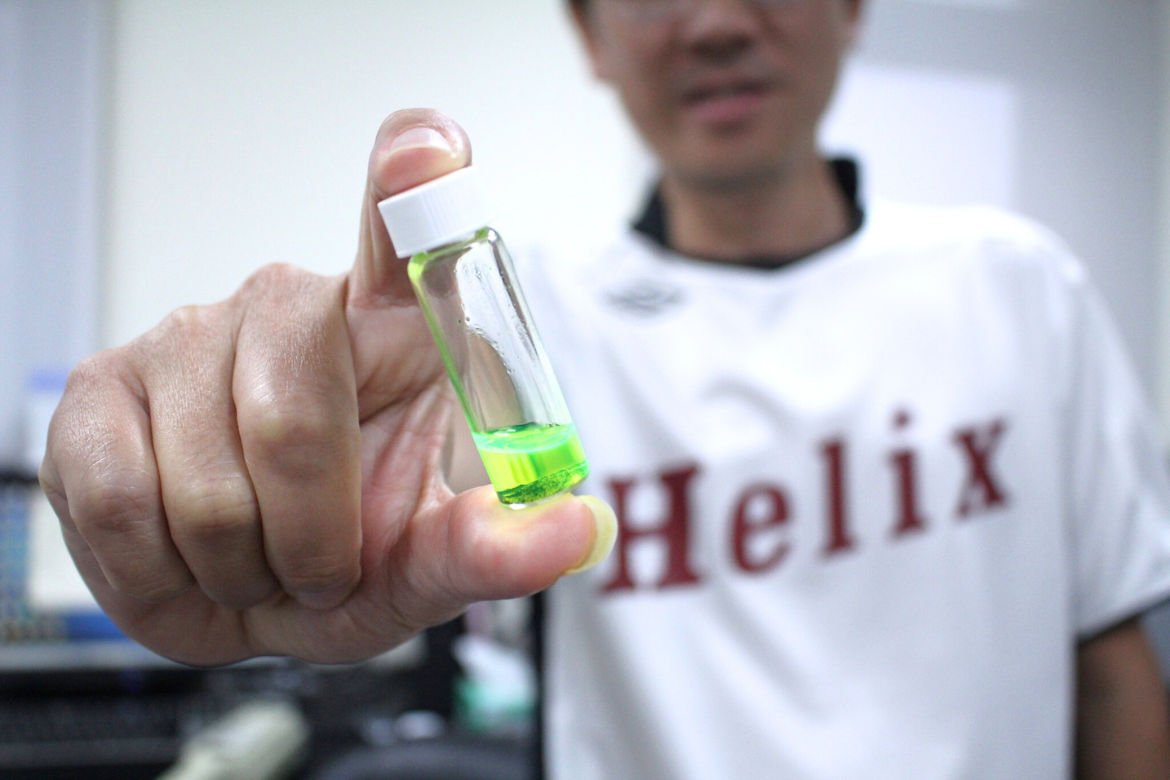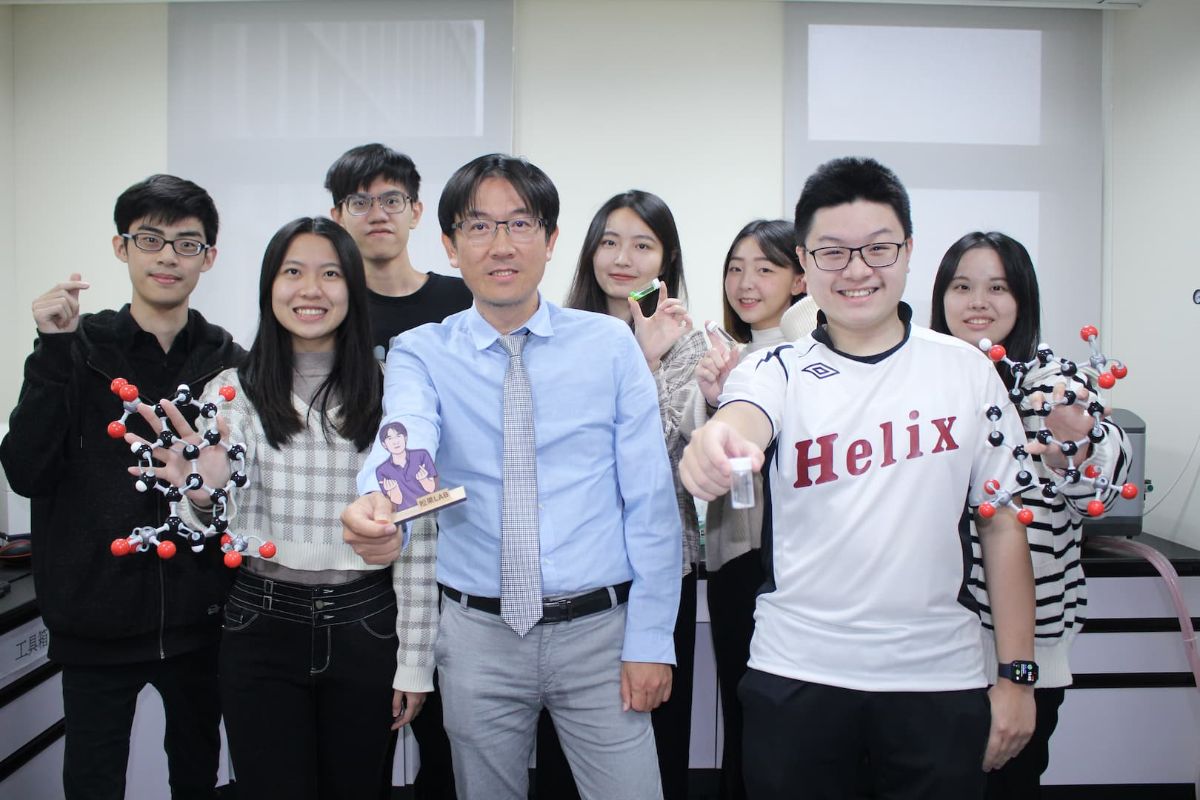RESEARCH HIGHLIGHTS
379
NYCU
Number of Academic Papers
Published by Students or Exhibition
Activities Organized by Students
- Update Date:2024-01-19
- Units:Office of International Promotion and Outreach
Breakthrough in Taiwan-Japan Collaborative Research: Development of Helical Nano Quartz Glass Paves the Way for a New Era in 3D Displays and Quantum Computers

The study involves incorporating achiral fluorescent molecules and solvents into nano-glass containers.
Mixing and adjusting the solvent ratios enables the free generation of circularly polarized luminescence ranging from green to blue.
Mixing and adjusting the solvent ratios enables the free generation of circularly polarized luminescence ranging from green to blue.
Translated by Yen-Chien Lai
______
Professor Ming-Chia Li's research team from the Department of Biological Science and Technology at National Yang Ming Chiao Tung University (NYCU) collaborates with a multinational research team involving Associate Professor Tomoyasu HIRAI from Osaka University and Professor Teruaki Hayakawa from Tokyo Institute of Technology.
Together, they have successfully developed circularly polarized luminescence (CPL) technology, allowing control of light emission from green to blue by placing fluorescent molecules and solvents into spiral-shaped nano-glass containers. This innovative technology finds applications in 3D displays and quantum computing.
Building on Innovation: Advancements in Nano-Glass Technology through Molecular Design Synthesis and Helical Structures
Prof. Ming-Chia Li stated that this research is a continuation based on the findings from 2021. The team employed molecular design synthesis techniques, utilizing anionic polymerization reactions with active ions. This led to the development of three-dimensional regular polymethyl methacrylate (PMMA) materials with side chains containing polyhedral oligomeric silsesquioxanes (POSS). The team successfully produced quartz glass containers with nanoscale helical structures through high-temperature firing.
The study involves incorporating achiral fluorescent molecules and solvents into nano-glass containers. Mixing and adjusting the solvent ratios enables the free generation of circularly polarized luminescence from green to blue. This successful establishment of control over molecular ground states and the regulation of optical activity can serve as a technological foundation for applications in stereoscopic 3D displays, nano-drug carriers, and the field of quantum computing.
Together, they have successfully developed circularly polarized luminescence (CPL) technology, allowing control of light emission from green to blue by placing fluorescent molecules and solvents into spiral-shaped nano-glass containers. This innovative technology finds applications in 3D displays and quantum computing.
Building on Innovation: Advancements in Nano-Glass Technology through Molecular Design Synthesis and Helical Structures
Prof. Ming-Chia Li stated that this research is a continuation based on the findings from 2021. The team employed molecular design synthesis techniques, utilizing anionic polymerization reactions with active ions. This led to the development of three-dimensional regular polymethyl methacrylate (PMMA) materials with side chains containing polyhedral oligomeric silsesquioxanes (POSS). The team successfully produced quartz glass containers with nanoscale helical structures through high-temperature firing.
The study involves incorporating achiral fluorescent molecules and solvents into nano-glass containers. Mixing and adjusting the solvent ratios enables the free generation of circularly polarized luminescence from green to blue. This successful establishment of control over molecular ground states and the regulation of optical activity can serve as a technological foundation for applications in stereoscopic 3D displays, nano-drug carriers, and the field of quantum computing.
Shaping the Future: 'Controlling Circularly Polarized Luminescence' Emerges as a Global Scientific Sensation in JACS Au
This significant research achievement, titled 'Controlling Circularly Polarized Luminescence Using Helically Structured Chiral Silica as a Nanosized Fused Quartz Cell,' has been published in the Journal of the American Chemical Society ‘JACS Au.’
The innovative perspectives and breakthroughs in the study have garnered numerous views and downloads from researchers in the global scientific community over the past month. Not only has it become a highly-read article in the journal (MOST Read), but it was also selected as the cover story for the November issue of JACS Au.
This significant research achievement, titled 'Controlling Circularly Polarized Luminescence Using Helically Structured Chiral Silica as a Nanosized Fused Quartz Cell,' has been published in the Journal of the American Chemical Society ‘JACS Au.’
The innovative perspectives and breakthroughs in the study have garnered numerous views and downloads from researchers in the global scientific community over the past month. Not only has it become a highly-read article in the journal (MOST Read), but it was also selected as the cover story for the November issue of JACS Au.

Professor Ming-Chia Li's research team
Related Image(s):












